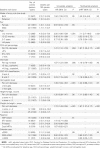Long-term survival of HIV-infected children receiving antiretroviral therapy in Thailand: a 5-year observational cohort study
- PMID: 21054181
- PMCID: PMC3106246
- DOI: 10.1086/657401
Long-term survival of HIV-infected children receiving antiretroviral therapy in Thailand: a 5-year observational cohort study
Abstract
Background: There are scarce data on the long-term survival of human immunodeficiency virus (HIV)-infected children receiving antiretroviral therapy (ART) in lower-middle income countries beyond 2 years of follow-up.
Methods: Previously untreated children who initiated ART on meeting immunological and/or clinical criteria were followed in a prospective cohort in Thailand. The probability of survival up to 5 years from initiation was estimated using Kaplan-Meier methods, and factors associated with mortality were assessed using Cox regression analyses.
Results: Five hundred seventy-eight children received ART; of these, 111 (19.2%) were followed since birth. At start of ART (baseline), the median age was 6.7 years, 128 children (22%) were aged <2 years, and the median CD4 cell percentage was 7%. Median duration of follow-up was 53 months; 42 children (7%) died, and 38 (7%) were lost to follow-up. Age <12 months, low CD4 cell percentage, and low weight-for-height z score at ART initiation were independently associated with mortality (P < .001). The probability of survival among infants aged <12 months at baseline was 84.3% at 1 year and 76.7% at 5 years of ART, compared with 95.7% and 94.8%, respectively, among children aged ≥1 year. Low CD4 cell percentage and wasting at baseline had a strong association with mortality among older children but weak or no association among infants.
Conclusions: Children who initiated ART as infants after meeting immunological and/or clinical criteria had a high risk of mortality which persisted beyond the first year of therapy. Among older children, those with severe wasting or low CD4 cell percentage at treatment initiation were at high risk of mortality during the first 6 months of therapy. These findings support the scale-up of early HIV diagnosis and immediate treatment in infants, before advanced disease progression in older children.
Figures





References
-
- WHO/UNAIDS. Towards Universal Access: Scaling up priority HIV/AIDS interventions in the health sector, Progress Report. http://www.who.int/hiv/pub/2009progressreport/en/ 2009. Accessed 10 February 2010.
-
- Boulle A, Van Cutsem G, Hilderbrand K, et al. Seven-year experience of a primary care antiretroviral treatment programme in Khayelitsha? South Africa. AIDS. 2010;24((4)):563–572. - PubMed
-
- UNAIDS/WHO/UNICEF. Report fromthe Consultative Meeting on Data Collection and Estimation Methods Related to HIV Infection in Infants and Children. 8–10 July 2008. New York.
-
- Sutcliffe CG, van Dijk JH, Bolton C, Persaud D, Moss WJ. Effectiveness of antiretroviral therapy among HIV-infected children in sub-Saharan Africa. Lancet Infect Dis. 2008;8((8)):477–489. - PubMed
Publication types
MeSH terms
Substances
Grants and funding
LinkOut - more resources
Full Text Sources
Medical
Research Materials

